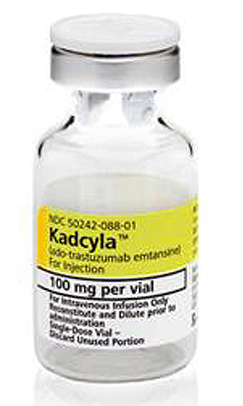The FDA approval of Roche/Genentech’s breast cancer treatment Kadcyla last week comes amid new research showing disturbing prevalence rates of the disease among women. But the drug’s price leaves some analysts pondering its fate.
Kadcyla, which was known during company clinical trials as T-DM1, extended the median survival of women with HER2-positive metastatic breast cancer by several months.
The treatment combines blockbuster Herceptin with a taxane chemotherapy, as well as a third chemical developed by San-Francisco based ImmunoGen and licensed by Genentech that binds the medicines together. The goal is for Herceptin to bind to a tumor site, where the chemo is locally released.
Sandra Horning, head of global oncology for Roche, described the cocktail as “a super-Herceptin,” in an interview with Bloomberg, and said the company sees potential for the drug, approved in the metastatic setting, to move into early breast cancer as well. An earlier forecast by Bernstein analyst Tim Anderson, MD, projected annual sales of CHF 623 ($660 million) by 2016.
On the heels of the approval comes new research suggesting the unmet need in breast cancer may have grown considerably: a study appearing in Journal of the American Medical Association showed that cases of advanced breast cancer in women under 40 has tripled in the US over the past 30 years. Particularly worrying is that those diagnosed at a younger age (20-34 years old) have a five-year survival rate of only 31%.
Roche/Genentech have priced Kadcyla at $9,800 per month, or $94,000 for a standard course of treatment. That’s double the cost of top-selling cancer drug Herceptin, which comes in at $4,500 per month. It follows the approval of Perjeta, which FDA sanctioned last year as a complement to Herceptin/chemo in treating first-line HER2-positive metastatic breast cancer and costs $6,000 a month.
With both drugs designed to be added on top of an already pricey therapy, they bring the rhetoric over cancer-drug price increases to a new level. “At some point, the ability to set such aggressive prices for oncology drugs in the US—even those like Kadcyla that extend survival—will be challenged,” said Marc Engelsgjerd, MD, senior analyst, inThought.
A sign of resistance to the notion of unfettered price increases for these drugs came in October, when Memorial Sloan-Kettering Cancer Center refused to use colorectal cancer treatment Zaltrap due to its high price tag. The fallout was cataloged in a New York Times op-ed by three physicians from the hospital, who lashed out at the FDA for pushing expensive drugs with minimal advantages over existing treatments: “In most industries something that offers no advantage over its competitors and yet sells for twice the price would never even get on the market. But that is not how things work for drugs. The Food and Drug administration approves drugs if they are shown to be ‘safe and effective,’” the group wrote. “It does not consider what the relative costs might be once the new medicine is marketed.”
Zaltrap was rebuffed because it was no more effective than Genentech’s Avastin yet, according to the doctors, was twice as expensive. In contrast, Kadcyla appeared to extend patients’ overall survival by nearly six months vs. standard of care in this setting, lapatinib and Xeloda (30.9 months vs. 25.1 months).
Still, relative costs could bring domestic prices in line with overseas models: “Cost-effectiveness considerations similar to those in Europe seems inevitable as, unfortunately, even the newest oncology drugs extend life by a few months, on average, and sometimes only when combined with other similarly expensive agents,” added Engelsgjerd.
Other analysts, like Gordon Gochenauer, Director, Kantar Health, said they believe Kadcyla offers a sound value proposition for its price, one which falls in line with other combination oncology agents. “It’s only slightly higher than the cost of Tykerb + Xeloda and at a similar price to Herceptin + Xeloda,” he said. “Both are reasonable alternatives to Kadcyla…However, one of the real advantages of Kadcyla is that it spares the patients from much of the toxicity of Xeloda or other chemotherapies…thereby reducing supportive care costs.”
That reduction in toxicity could make a real difference in treating cancer. “This antibody goes seeking out the tumor cells, gets internalized and then explodes them from within. So it’s very kind to patients—there’s no hair loss, no nausea, no vomiting,” said Dr. Melody Cobleigh of Rush University Medical Center, who helped conduct studies of the drug, the AP reported.
Nevertheless, Gochenauer said he expects payers to fiercely enforce the drug’s second-line indication. Kadcyla was approved for patients who fail to respond to Herceptin and a taxane. He said that “in the short term, payers will hassle MDs enough to ensure that patients are previously treated with Herception to minimize any off-label use of Kadcyla.”
But Gochenauer said the real issue for payers may come from the pending MARIANNE trial. Currently in Phase III, this study is testing a combination of Kadcyla and the Roche/Genentech drug Perjeta as a potential first-line combination chemotherapy treatment for HER2-positive breast cancer that could “push the cost of therapy in first-line to over $15,000/month.”
For now, the pricing trend along with Kadcyla appears here to stay. “We’ll continue to see prices increase,” Gochenauer said, “particularly when the drugs bring a good value proposition by showing high efficacy, a better toxicity profile and [if it] meets an unmet need, while payers will manage utilization to a higher extent.”








